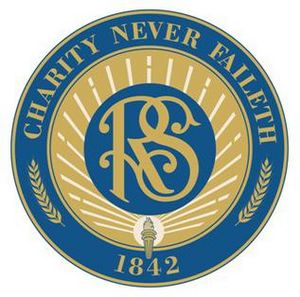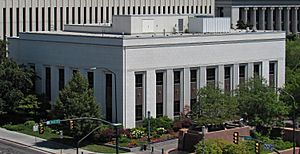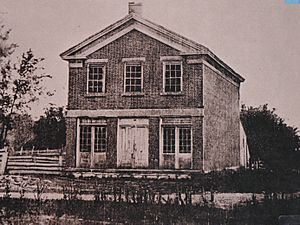Relief Society facts for kids

Relief Society Seal
|
|
| Formation | March 17, 1842 |
|---|---|
| Type | Non-profit |
| Purpose | Gospel instruction, women's/familial support, humanitarian aid |
| Headquarters | Salt Lake City, Utah, United States |
|
Membership
|
Over 7 million women, in over 188 countries |
|
General President
|
Camille N. Johnson |
|
Parent organization
|
The Church of Jesus Christ of Latter-day Saints |
The Relief Society is a special group for women in The Church of Jesus Christ of Latter-day Saints. It helps people and teaches important things. It started in 1842 in Nauvoo, Illinois, United States. Today, it has over 7 million members in more than 188 countries. Many people call it one of the oldest and largest women's groups in the world.
Contents
What the Relief Society Does
The main idea of the Relief Society is "Charity never faileth." This means love and kindness never give up. The group helps women grow their faith in God and Jesus Christ. They also work to make families and homes stronger. A big part of their work is helping people who are in need. They do this by working together and supporting each other.
How the Relief Society Started
Early Days in Nauvoo
In the spring of 1842, a woman named Sarah Granger Kimball wanted to sew clothes for workers building the Nauvoo Temple. She and her friend, Margaret A. Cook, decided to ask other women to help. They asked Eliza R. Snow to write some rules for their new group.
When Joseph Smith, the church leader, saw the rules, he said he had a better idea. He wanted to organize the women in a special way, like the church's priesthood. So, on March 17, 1842, twenty women met in Nauvoo, Illinois. They met in a room above Joseph Smith's Red Brick Store.
At this meeting, Emma Smith was chosen as the first president. She then picked two helpers, Sarah M. Cleveland and Elizabeth Ann Whitney. Joseph Smith explained that the group would help the poor and needy. They would also help women become better people. The group was named "The Female Relief Society of Nauvoo."
The Relief Society quickly became very popular. It grew so fast that they had to divide into smaller groups. By 1844, there were 1331 women in the group. The meetings in Nauvoo stopped in March 1844. After Joseph Smith passed away, Brigham Young became the new church leader. He decided to pause the Relief Society meetings before the church members moved west.
Moving West to Utah
When the church members moved west in 1846, Eliza R. Snow kept the Relief Society's records safe. Even though the group didn't meet officially, women still helped each other. They cared for those in need without a formal organization.
As people settled in the Salt Lake Valley, women started to meet again. In 1854, women in Salt Lake City formed an "Indian Relief Society." They made clothes for Native American women and children. Brigham Young encouraged women to start similar groups in their own local areas. By 1858, many groups had formed in different towns. These groups helped the poor, especially new settlers, and made things for their meetinghouses. However, many of these groups stopped meeting during the 1858 Utah War.
Rebuilding and Growing
In 1867, Brigham Young asked for the Relief Society to be reorganized in every local area. Eliza R. Snow helped set up these new groups. She used the old Nauvoo meeting notes as a guide. This helped all the groups work together with the same goals. By the end of 1868, groups were active in many places in Utah.
The women helped their local leaders care for the poor. They collected money and goods, nursed the sick, and cleaned homes. They also planted gardens and taught each other important skills. Eliza R. Snow became the General President in 1880. She taught women to be spiritual and self-reliant.
The Relief Society helped women go to medical school and trained nurses. They even opened a hospital called Deseret Hospital. They also encouraged women to save wheat and built places to store it. In 1872, Eliza R. Snow helped start a women's newspaper called the Woman's Exponent. By 1888, the Relief Society had over 22,000 members. In 1891, it became a founding member of the National Council of Women of the United States.
In the early days, Relief Society meetings were held twice a month. One meeting was for sewing and helping the poor. The other meeting was for learning and sharing ideas. Women were also encouraged to explore cultural activities in their communities.
The 20th Century and Beyond
The Relief Society Magazine was the official publication from 1915 to 1970. By 1942, there were about 115,000 members. This grew to 300,000 members by 1966. In 1945, the group's official name became "Relief Society of The Church of Jesus Christ of Latter-day Saints."
In the 1960s, the church made some changes that helped the Relief Society grow worldwide. Lessons and materials became easier to translate for people in different countries. The Relief Society Magazine stopped being published in 1970. It was replaced by a new church magazine called the Ensign.
How the Relief Society Works Today
When a Latter-day Saint woman turns 18, or if she gets married earlier, she joins the Relief Society. There are no fees or dues to be a member.
Local Leadership and Meetings
In each local church area, called a ward, there is a Relief Society president. She chooses two other women to help her. Together, they lead the Relief Society in that ward. They work with the local church leader, called a bishop, to help the women in their area. There are also larger groups of leaders who oversee several local Relief Societies.
Relief Society meetings are held twice a month and last about 50 minutes. During these meetings, a lesson is taught by one of the leaders or another woman. The lessons often come from recent talks given at the church's general conference. The Relief Society also helps teach basic reading and writing skills to those who need them. As of February 2020, the Relief Society had over 7 million members in 188 countries.
Church-Wide Leadership
Three women are chosen by the church's top leaders to lead the entire Relief Society worldwide. They are called the General Relief Society Presidency. They are based in Salt Lake City and are the highest-ranking women in the church. Since August 2022, the General Relief Society Presidency has been Camille N. Johnson as president, J. Anette Dennis as first counselor, and Kristin M. Yee as second counselor. They get help from a special council of women.
From the 1970s to 2013, the Relief Society held a big meeting in Salt Lake City once a year. This meeting was broadcast around the world. It was a chance for the General Relief Society Presidency to talk to all the women in the church.
In 2014, these meetings changed. Now, there is a women's meeting held twice a year, in March and September. This meeting is for all women and girls in the church aged eight and older. Since 2018, this meeting is part of the church's regular general conference in October.
The Relief Society Building

In Salt Lake City, Utah, the Relief Society has its own special building. It's called the Relief Society Building. This building is separate from other church offices. It's the only church group that has its own building like this. It is also the closest building to the entrance of the Salt Lake Temple.
Relief Society Programs
Ministering Sisters
In every local church area, each Relief Society member is paired with another member. These pairs are then asked to be "ministering sisters" to one or more other women. Ministering sisters try to stay in touch regularly with the women they are assigned to. This might be through a visit, a phone call, an email, or a letter. Ministering sisters look for ways to help and serve the women they minister to.
In April 2018, the church leader, Russell M. Nelson, announced a new program called "ministering." This replaced older programs like "visiting teaching." Now, ministering sisters work with other church leaders to help people.
Compassionate Service
The Relief Society president in each local area is very important for helping members. She works with the bishop to make sure people's needs are met. The Relief Society helps women learn how to be self-reliant and prepared. They also teach about serving others with kindness. Many groups have a Compassionate Service Leader. This person helps organize service projects and helps members during hard times.
Activity Meetings
An evening Relief Society meeting is usually held a few times a year in each local church area. At these meetings, women learn new skills, work on service projects, and spend time together. Local groups can also have other informal meetings for women with similar interests. These meetings are a chance for women to learn and connect.
See also
 In Spanish: Sociedad de Socorro para niños
In Spanish: Sociedad de Socorro para niños
- Family Services
- Worship services of The Church of Jesus Christ of Latter-day Saints




